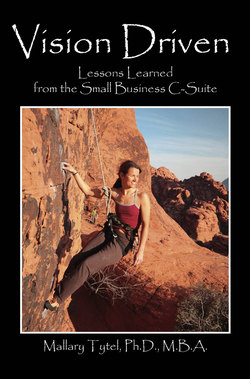Читать книгу Vision Driven: Lessons Learned from the Small Business C-Suite - Mallary JD Tytel - Страница 19
На сайте Литреса книга снята с продажи.
Thinking about the Future
Оглавление“When men speak of the future, the Gods laugh.”
Chinese Proverb
Part of being human is our desire to predict and control the future. As we become more intelligent and as technology advances, we are constantly learning a thing or two about how much influence we really do have on future events. Forget about psychics and crystal balls; nowadays computer simulations and algorithms present us with sophisticated options for thinking about the future. Of course, there are no guarantees.
In order to shape a preferred future you need to have a picture in your mind of what it is you really want.
Let’s take a page from futurists, seers and planners. Imagine it is ten years from now. Think about how old you will be. How old will your children be? How old will your closest friend be? Now let that thought grow.
•What kind of work will you be doing?
•What will you be learning and how will you be learning?
•What will you believe in?
•In what different ways will you find joy?
•What will worry you the most?
•What will you hope for?
Now think about your organization. Remember it is still ten years from now.
•Will it still exist?
•Will it be different? How?
•What will your world of work be like?
•What are your hopes for the future of your company?
•What are the implications for your thinking, planning and actions starting today?
As your challenges become more apparent, you can become more conscious about the gap between the way the world is and the way you would like it to be. You can address this with action.
From a financial perspective, this might mean developing new customers and new contracts; better financial and budget management techniques; new operating and accounting systems; and a healthy bottom line.
From a customer perspective, this might mean providing and adding value through enhanced relationships; collecting and analyzing client data; developing ground-breaking products and services; shifting to a more innovative culture of doing business; and managing private and public market segmentation.
From a perspective of organizational excellence, this might mean expanded, efficient systems, processes and quality standards; an effective communication plan; and enhanced performance management procedures with built in rewards and recognition.
From a perspective of innovation, learning and creativity, this might mean escalating research and development functions; expanding the corporate white space; and proactively developing new products and services to remain at the edge of anticipated changing markets.
Individually, you can ask yourself if what you are doing is ...
•Moving you forward to reach your goals?
•Bringing business in the door?
Collectively as a group, your organization can identify what you will need to reach your shared vision.
•Communicating openly, consistently, often and in all directions
•Innovating
•Identifying and measuring internal and external results
•Understanding and responding to your market
•Striving for and achieving excellence
•Maximizing financial and human resources
•Maintaining ongoing dialogues with colleagues and providing resources for improvement
•Showing an appreciation for diversity
•Providing feedback into the system
Keeping this in mind, the following questions are for your careful consideration:
•How will you manage the certainty of uncertainty?
•What are the implications of your answers to these questions in your thinking, planning and actions today?
Now, what are you waiting for?
